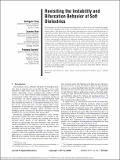Revisiting the Instability and Bifurcation Behavior of Soft Dielectrics
Author(s)
Yang, Shengyou; Zhao, Xuanhe; Sharma, Pradeep
Downloadjam_084_03_031008.pdf (1.260Mb)
PUBLISHER_POLICY
Publisher Policy
Article is made available in accordance with the publisher's policy and may be subject to US copyright law. Please refer to the publisher's site for terms of use.
Terms of use
Metadata
Show full item recordAbstract
Development of soft electromechanical materials is critical for several tantalizing applications such as human-like robots, stretchable electronics, actuators, energy harvesting, among others. Soft dielectrics can be easily deformed by an electric field through the so-called electrostatic Maxwell stress. The highly nonlinear coupling between the mechanical and electrical effects in soft dielectrics gives rise to a rich variety of instability and bifurcation behavior. Depending upon the context, instabilities can either be detrimental, or more intriguingly, exploited for enhanced multifunctional behavior. In this work, we revisit the instability and bifurcation behavior of a finite block made of a soft dielectric material that is simultaneously subjected to both mechanical and electrical stimuli. An excellent literature already exists that has addressed the same topic. However, barring a few exceptions, most works have focused on the consideration of homogeneous deformation and accordingly, relatively fewer insights are at hand regarding the compressive stress state. In our work, we allow for fairly general and inhomogeneous deformation modes and, in the case of a neo-Hookean material, present closed-form solutions to the instability and bifurcation behavior of soft dielectrics. Our results, in the asymptotic limit of large aspect ratio, agree well with Euler's prediction for the buckling of a slender block and, furthermore, in the limit of zero aspect ratio are the same as Biot's critical strain of surface instability of a compressed homogeneous half-space of a neo-Hookean material. A key physical insight that emerges from our analysis is that soft dielectrics can be used as actuators within an expanded range of electric field than hitherto believed.
Date issued
2017-01Department
Massachusetts Institute of Technology. Department of Civil and Environmental Engineering; Massachusetts Institute of Technology. Department of Mechanical EngineeringJournal
Journal of Applied Mechanics
Publisher
ASME International
Citation
Yang, Shengyou, Xuanhe Zhao, and Pradeep Sharma. “Revisiting the Instability and Bifurcation Behavior of Soft Dielectrics.” Journal of Applied Mechanics 84, no. 3 (January 24, 2017): 031008.
Version: Final published version
ISSN
0021-8936